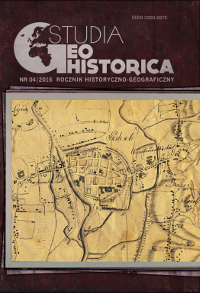Handel wołami na terenie Wielkopolski i Śląska w świetle szesnastowiecznego spisu jarmarków i komór celnych
The Trade in Oxen on the Territory of the Greater Poland and Silesia in the Light of the 16th Century Description of Annual Fairs and Toll Houses
Author(s): Anna Paulina Orłowska, Bartosz NowożyckiSubject(s): Regional Geography, Economic history, 16th Century
Published by: Polskie Towarzystwo Historyczne
Keywords: handel;jarmarki;woły;Wielkopolska;Śląsk;Lipsk;Saksonia;XVI wiek;trade;annual fairs;oxen;Greater Poland;Silesia;Leipzig;Saxony;16th century
Summary/Abstract: The trade in oxen, along with the trade in grain, was one of two most important branches of Polish export trade in the 16th c. Both merchandises were produced in the Polish-Lithuanian kingdom and were exported to Western Europe. However, the specific trade routes differ due to the different properties of these goods. While grain was a typical bulk good, the transport of which required cheap means of transportation, it was exported via sea and delivered to harbours through rivers, the trade routes of oxen ran orthogonal to those of grain (i.e. parallel to the sea), for the simple reason that oxen can move on their own. Furthermore, the final destinations of these goods lay in the annual fairs in Silesia and Saxony which were located far from the Baltic Sea. These trade routes typically began in the south- -east, around the Moldavian regions, and crossed the country towards the north-west. Analysing the history of these trade relations is uncommonly challenging since most of the official sources were destroyed during World War II. The source investigated in the present text was transmitted through a private archive (it belonged to the Branicki family) and thus, it survives to this day. The text in question is written in a paper booklet of only six pages, giving no information on the time and place of its origin, or about the author. It is not even clear whether the writer was the actual author or whether the text is a copy of another manuscript. The aim of the text is to explain the proper behaviour for the observant of the oxen trade. The intended reader was to be interested in trade due to his occupation such as a young merchant or a toll keeper. The manuscript details the steps necessary or helpful for dealing with the annual fairs and toll houses of Greater Poland, explaining how to retrace the path of the oxen, e.g. looking out for how often how many oxen were given water. The text assumes a chronological structure, i.e. it starts in January and abruptly ends in November. The reasons why the second half of November and December are missing are not clear – several pages are left blank. To the researches, these descriptions provide a unique insight into the functionalities of the annual fairs in Greater Poland of those times, and the mechanisms of their trade.
Journal: Studia Geohistorica
- Issue Year: 2016
- Issue No: 4
- Page Range: 153-161
- Page Count: 9
- Language: Polish

